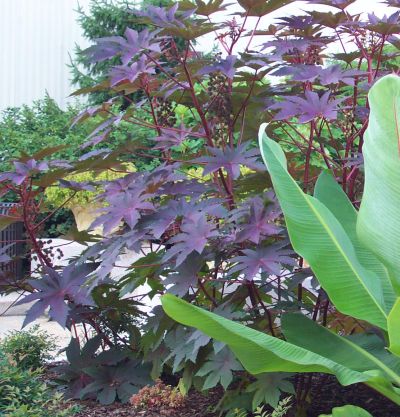Castor Bean – Ricinis communis. Folks who make their living creating fabulous color displays for public gardens, municipalities, and commercial parks love ‘em. Civilian gardeners/plant geeks love ‘em. People who get their knickers in a twist about poisonous plants do not.
Pros: ridiculously rapid growth, huge leaves for that tropical look, tolerant of less-than-ideal conditions, cheap and easy to grow from seed, weird wild flowers and seed pods.
Cons: pretty darn poisonous. A few seeds (have seen figures from four to 20), chewed up to release the toxic protein ricin, will allegedly kill you. A Caster Bean seed looks like a really huge tick (head and all), which should be sufficiently repellent to anyone over ten years old. Pleh.

Beans with flowers. U.S. Botanic Garden, 2005, Washington D.C.
This topic arises because I was standing in our campus garden yesterday with said pot o’ poison (cultivar ‘Carmencita’, a red-leaf form), trying to find a place to plant it. Last summer, my department head noted them growing in front of our garden pavilion and asked that I kindly remove them. “They’re really poisonous, and kids will stick anything in their mouth, and I wouldn’t want my kids around them” (quoted best of my memory). He’s a wonderfully laid-back guy, so it struck me that he must really be concerned to bring it up. I teach Castor Bean in my Herbaceous Landscape Plants class for both the pros and the cons…heaven forbid a Hort graduate is unable to identify it, so I persuaded him into letting me keep it up if I removed the seed pods before they ripen. I’m not going to go into all the medicinal/industrial uses of castor oil (ick…I hope my generation was the last to have this foisted on us) nor the insidious uses of ricin – Google away if you’re interested.
We temperate-zone gardeners love anything tall and big-leaved to give vertical “oompf” to summer beds and container plantings. The tropical African native is considered an invasive plant throughout the subtropics; I’ve seen it in pastures and fence rows in far south Florida, the Cayman Islands and Dominican Republic. Apparently the cows and goats have learned to avoid it (natural selection?). I noticed it used en masse in the gorgeous beds lining the street in downtown St. Louis last summer, as well at several other public gardens I’ve visited over the past few years. So I’ll continue to use it in our garden’s palette of plants, but will remove the pods to keep everybody happy.
p.s. At the top of my summer reading list is Amy Stewart’s book “Wicked Plants”.